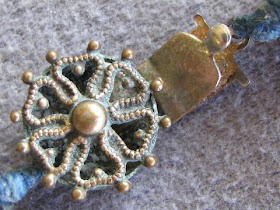Did one of the old master craftsmen who used to make intricate cloisonne beads for Qing court necklaces apply his skills for the delight of a lady? Could this be a piece from Helen Burton's 1920-30s Camel Bell shop in the Peking Hotel? So mysterious.
A Haskell-attributed necklace featuring hexagonal cylinder beads in a simpler reverse-openwork technique, where the background is filled with enamel instead of the insides of the cloisons:
 |
| The center bead, which the vendor describes as featuring birds and flowers, seems to be Canton enamel. |
 |
| Note the fired-once concave enamel |
 |
| The three large round beads upper left appear to be in a technique similar to the necklace beads, as does the pendant upper right. The large cloisonne cylinder may be a scroll weight? (example below) |
 |
| What appear to be flat cloison wires, in contrast to the twisted wires used in the bead pictured above. |
 |
| Japanese cloisonné scroll weights with tassels. |
http://chinese-export-silver.com/meta-museum-archive/meta-museum-chinese-export-silver-enamel-revival-phenomenon-中國出口銀器-開始轉寄郵件/
UPDATE: I acquired the beads shown in the upper left of the assemblage photo. Here's what they look like up close:
 |
| The overall green cast is verdigris, which I have not removed. |
Similar wirework and enamel can be seen in boxes that appear, from their "CHINA" stamps, likely to date from the 1910s-30s.
UPDATE: What appears to be a group of graduated beads in a gourd motif, possibly salvaged from a necklace [Liveauctioneers website, item 64835265]

.JPG)

.JPG)







.JPG)
















No comments:
Post a Comment